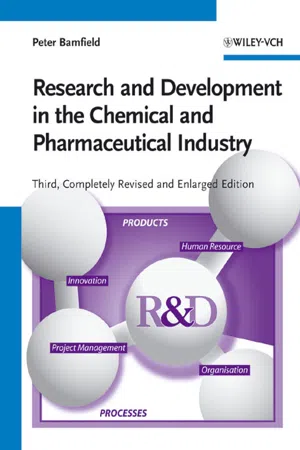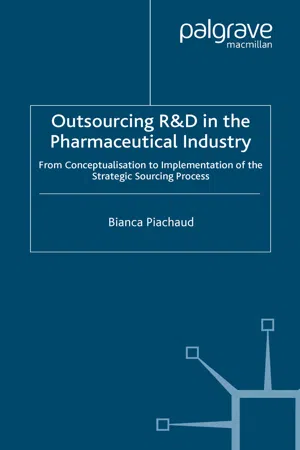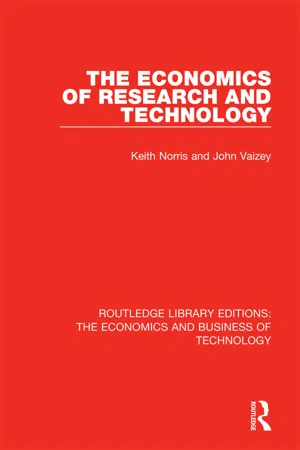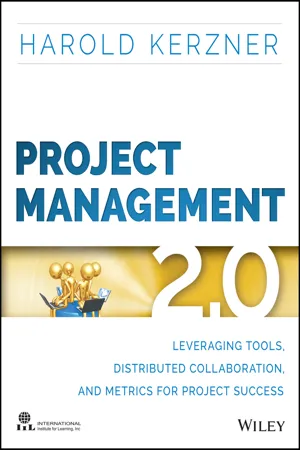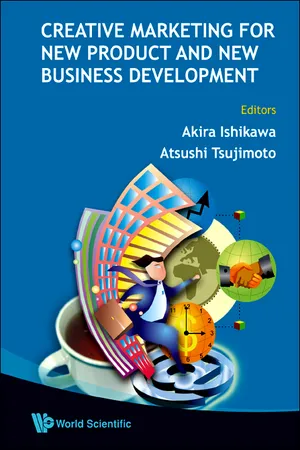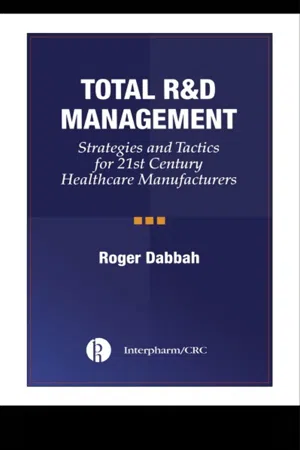Business
Research And Development
Research and Development (R&D) refers to the process of investigating, experimenting, and innovating to create new products, services, or processes. It involves activities aimed at gaining new knowledge and applying it to develop or improve existing offerings. R&D is crucial for businesses to stay competitive, drive innovation, and meet evolving customer needs.
Written by Perlego with AI-assistance
Related key terms
1 of 5
12 Key excerpts on "Research And Development"
- eBook - PDF
Strategic Business Planning for Accountants
Methods, Tools and Case Studies
- Dimitris N. Chorafas(Author)
- 2006(Publication Date)
- CIMA Publishing(Publisher)
Taken together, all these reasons work against creating the right condi-tions to attract investments, while falling behind in R&D discourages the new initiatives and new thinking that promote innovation. Take information technology as an example. With Olivetti, Italy had one of the global players, but poor management saw to it that Olivetti went to the wall. This is bad for competitiveness, because the markets for hardware platforms, basic software applications, and tools are continuing to grow. This is fed through inno-vation in products and services projected to appeal to the unique requirements of specific markets, with: Products designed to be readily available and affordable Technologies that offer greater value in meeting many targeted customer needs, and Any-to-any communications that integrate the best available current solu-tions. Being ahead of the curve, however, requires considerable investments in basic and applied research. As a generic term, research is the process of investigating, exploring, and enquiring, as well as fact-finding, scrutinizing, examining, prob-ing, analysing, and experimenting. In science, research divides into: Basic , which aims at uncovering physical laws, principles, facts, and materials Applied , which targets practical application of basic research findings, leading to new product development. The process of development aims to bring forth more advanced or more cost-effective products, services, and systems. In this sense, development means evo-lution, advancement, evolvement, and is therefore a fundamental ingredient of progress in: Industry, and Society at large. When properly managed, the money spent on Research And Development, as well as in marketing and sales (M&S) positively impacts on revenues, income, and earnings per share. Figure 14.1 presents a snapshot of evolution in the key vari-ables of corporate performance from one of the leaders in the global software business – over three consecutive years. - Peter Bamfield(Author)
- 2006(Publication Date)
- Wiley-VCH(Publisher)
The further development of existing products and processes in terms of cost, qual- ity and environmental impact. 2. The invention of new products and processes for existing businesses. 3. Strategic Research, i.e. new business and technology or competency building to support or underpin the longer-term business goals. The process that is used to generate targets for R&D personnel will depend on which of these three categories is being considered. It will also depend on the environment in which the R&D work will be carried out. Will it be within a separate, functional R&D department, as part of project team in a matrix organisation or as a fully integrated part of a strategic business unit? Whilst these latter differences are important, they are really only refinements of the general method. There are generic guidelines, which can be applied in all situations, and it is these that will be discussed in this Section. 1.2.1 The Development of Existing Products and Processes Improving existing products and increasing plant output is very cost efficient work for R&D. The further development of those products which are currently being sold and the processes by which they are being made, is an essential activity in maintaining the product line and the financial health of the company, whilst new products and processes are in the pipeline. 1.2 The R&D Portfolio 219 The main component of this type of developmental work is a detailed evaluation of the manufacturing processes used to make the company’s products. The targets are therefore derived from discussions within the company after considering the eco- nomic climate in which the derived products and business must perform and, im- portantly, how customers view the current product line or ranges. The benefits that are being sought from process development work are: • Cost. Reductions in the manufacturing costs and hence an improved profitability or competitiveness of the products.- eBook - ePub
From Followers to Leaders
Managing Technology and Innovation
- Naushad Forbes, David Wield(Authors)
- 2002(Publication Date)
- Routledge(Publisher)
We go on to show how global R&D is concentrated: most is focused in a handful of countries and a handful of industries and firms. It is an enormously expensive enterprise. The R&D effort, of even the largest, most technologically advanced developing countries cannot match that of the major industrial nations or the largest corporations. Fortunately, they do not have to. An increased focus on R&D in NICs can pay rich dividends. Alone, though, this argument is hardly new: politicians and academics of every kind in NICs have been arguing the virtues of increased R&D for at least four decades. What matters is how this R&D is focused. Focus is far more critical to the success of industrial innovation than the level of R&D spending. We develop an argument as to how R&D can be focused in NICs on those activities that will force firms up the value-chain.What is R&D?
Policy-makers, academics and business see R&D as a well-defined term. The prime minister of India exhorts the nation to ‘treble the per cent of GNP spent on R&D to 2 per cent’. An academic studying responses to liberalization by firms in Latin America notes the ‘absence of a strong R&D base’. A businessman in the US seeks to ‘redirect R&D activities to research directly relevant to the firm's strategy’. All think they are talking about the same thing, indeed the same well-defined thing. This is not so. As we will see later in this chapter, it is the content of R&D that matters, and here understanding is very limited outside a few technology-leading firms. We will delve ‘inside the black box’ of technical change, to see what is actually happening when a firm is said to be doing R&D.R&D in NICs has played many roles
The conventional role of R&D is the development of new products and processes. In 1998, Mowery and Rosenberg began their book on technological change in the US with Alfred North Whitehead's observation that:The greatest invention of the 19th century was the invention of the method of invention. It is a great mistake to think that the bare scientific idea is the required invention, so that it has only to be picked up and used. An intense period of imaginative design lies between. One element in the new method is just the discovery of how to set about bridging the gap between the scientific ideas, and the ultimate product. It is a process of disciplined attack upon one difficulty after another.1From the late nineteenth century onwards, this ‘disciplined attack’ was institutionalized in in-house R&D departments in firms first in Germany (primarily in the chemical industry) and later also in the US (in both the chemical and electrical industries). By 1921, US firms employed just under 3,000 scientists and engineers in their industrial research laboratories. This grew to 46,000 in 1946, by which time leading industrial firms world-wide had established their own R&D laboratories. The period after the Second World War saw the greatest growth in industrial R&D, with US industrial R&D employment rising to almost 800,000 in 1996. R&D employment in firms in most developed countries also rose sharply in the post-war years. - eBook - ePub
The Challenge for Japanese Multinationals
Strategic Issues for Global Management
- H. Takahashi(Author)
- 2013(Publication Date)
- Palgrave Macmillan(Publisher)
In general, business activities follow this procedure: (1) explore/research market needs and the technical seeds owned by the company, (2) develop these needs and seeds by making new products, (3) make these products a reality through the production processes, and (4) sell them. It is important to note, however, that at the outset corporations primarily develop products to be sold in their home countries, not in foreign markets. In other words, even MNCs begin their business activities as national firms and then expand their business overseas. This means that at the beginning they prioritize “buy national” policies (purchases in the domestic market) as an underlying premise, and do not carry out marketing or production activities in foreign countries. So a significant proportion of MNCs are less eager to move their Research And Development functions overseas, even after they have established production bases in foreign countries. Compared to production or marketing activities, corporations prefer to concentrate Research And Development in their home countries.Research And Development is the key to business activities, since this process represents the production of products under a company’s product–market strategy. These activities are therefore carried out internally under a veil of secrecy to keep them hidden from others. This is one reason that R&D is generally kept inside a company’s domestic headquarters, isolated from outside world. The reasoning behind this is given below.First, Research And Development can be categorized according to the scale of economies. Significant investment is required to secure experimental facilities and human resources, including researchers and engineers, to conduct R&D. Decentralizing these facilities and human resources requires even more investment, which can cause problems in terms of R&D efficiency.Second, Research And Development require smooth communication. R&D is an intimate human process that moves from innovative ideas and ingenuity to concepts, invention, and discovery. Participants must gather in a specific place if they are to effectively communicate and inspire one another. It is therefore better to concentrate R&D functions in the home country, since this allows the team to easily communicate with each other in their own language at headquarters.Third, it is necessary to protect know-how. Technologies and ideas created through the Research And Development process are precious company assets and can be protected by patents and other means. Also, it is easier to concentrate the R&D process and control human resources when centralized at the home country’s headquarters. - eBook - ePub
Industrial Organization
Competition, Growth and Structural Change
- Kenneth George, Caroline Joll, E L Lynk(Authors)
- 2005(Publication Date)
- Routledge(Publisher)
The subject matter of this chapter is often referred to for simplicity as technological change. However, it is important to recognise at the outset that the process of technological change is a complex one. Schumpeter (1947) distinguished between three main stages: invention, innovation and diffusion. Invention is the production of new knowledge in the form of a new product or method of production. Innovation covers the whole range of activities that are needed to translate a new idea into commercial practice for the first time. They include the further, possibly extensive, development and refinement of an idea before the stage of commercial application can be reached. It may involve extensive laboratory and clinical testing, as in the case of pharmaceuticals, or the building of prototypes, as in the case of vehicle or aircraft development. In many cases the development of a new idea may depend on other scientific advances. The development of new aero engines, for instance, has depended on the parallel development of new materials. The innovation stage also includes identifying the market for a new product, investing in the capital goods needed for production and distribution, and raising the funds for that investment. The third of Schumpeter’s stages—diffusion—is the stage when a product or process innovation is spread through the market, either through the efforts of the innovator or as a result of imitation by other firms.It is also quite common to distinguish between the following categories of R&D activity: basic research, strategic research, applied Research And Development. Basic research is aimed at the discovery of new knowledge for its own sake with no thought for immediate application. Strategic research has foreseeable application though this may not be clearly defined. Applied research is aimed at obtaining knowledge for specific industrial application. Development refers to the application of existing knowledge to the production of new products or processes. These categories do not represent watertight compartments but the distinctions made can be useful. In particular, the distinction drawn between basic and other forms of research activity will be of importance when we come to discuss the adequacy of markets in funding R&D activity.We now turn to the main issues in the economics of technological change. The next section examines the relationship between firm size and R&D activity. This is followed in section 9.3 by an analysis of the interrelationship between R&D and market structure. Section 9.4 examines the wider issue of whether the free play of market forces would tend to allocate too few resources to R&D activity. Lastly, section 9.5 considers the diffusion of new technology and the economics of the patent system. - eBook - PDF
Outsourcing of R&D in the Pharmaceutical Industry
From Conceptualization to Implementation of the Strategic Sourcing Process
- Bianca Piachaud(Author)
- 2004(Publication Date)
- Palgrave Macmillan(Publisher)
Roussel et al. (1991) have identified three approaches to R&D management which reflect three different Core Competencies and Approaches to R&D 87 88 Outsourcing R&D in the Pharmaceutical Industry points of view: (1) R&D as the ivory tower, where new product ideas are produced and developed, isolated from the rest of the company; (2) R&D as a function that is integrated with business management and is therefore strongly market orientated; and (3) R&D as a function which balances market-driven exploitation of technological opportuni- ties and the exploration of new findings, and is thus linked in an operational and strategic partnership with business management. 7 Although approaches to managing R&D have changed over time, it has always been viewed as one function from an organisational point of view. The taxonomy of R&D organisations is usually input-orientated (that is by scientific discipline), and output-orientated (that is by prod- uct line) and matrix organisations. 8 Yet in the past few years, other approaches have emerged. Firms have either changed the ways in which R&D is organised or have re-thought the overall structure of R&D on the basis of technological competence. This indicates that within R&D, there are activities that are very different in nature and would thus require different organisation and managerial approaches. 4.2 The Research And Development process The R&D process as pertinent to the pharmaceutical industry is briefly outlined in Figure 4.1. It is composed of two distinct phases: drug discovery which aims at discovering a new compound and the development phase which aims at evaluating the effectiveness of the new compound. 9 Phase 1: drug discovery The process of developing a new drug can only begin once a compound containing potentially valuable medicinal properties has been discovered. - eBook - ePub
- Keith Norris, John Vaizey(Authors)
- 2018(Publication Date)
- Taylor & Francis(Publisher)
A firm can expand by diversification and/or by the acquisition of other firms. Growth by diversification can occur either through the development of new products or through entering existing markets which the firm had previously ignored. Before we consider the influence of research and technology on these two alternative directions of growth, it is useful to be clear about the immediate objectives of industrial Research And Development expenditures. A survey carried out in the U.S.A. in 1966 estimated that the main objectives of Research And Development expenditures were new product development in 45% of companies, product improvement in 41%, and new processes in 14%. What little information there is for the U.K. suggests that there is rather more emphasis here on new processes, although product research is the main objective of about two-thirds of firms. New products sometimes imply new production processes, but more usually they can be produced by modifying existing processes.In order to grow through diversification, a firm has to shift the demand curve for its products outwards to the right. We are here talking of the demand curve for all of the products of the firm—a sort of corporate demand curve.1 The types of expenditure whose main object is to shift the demand curve in this way have been referred to as growth inducing expenditures. Important among such activities are advertising, marketing, and Research And Development. One direction of growth is by developing new products and the central role of Research And Development in furthering corporate objectives in this way is clear. To get the emphasis between Research And Development right, we must remember that new products in this sense need only be slight improvements in existing products, implying the importance of development rather than research expenditures. Research can be important in developing new products and may give a company a longer lasting lead than do trivial improvements. The new tyre developed by Dunlop that will remain inflated even when punctured is probably a case in point. Biological washing powders, however, although the outcome of research programmes, have not given the innovator a lasting lead because competitors had been engaged simultaneously in similar research.Another form of diversification is expansion into new markets. Here the notion of a ‘technological base’ is important. A technological base of a firm exists where there are a group of productive activities in which certain materials, machines, skills, and processes are closely associated and complementary to one another.2 A firm may have more than one technological base, and in such cases the bases will often be linked by common scientific and technological knowledge. Penrose and others have stressed the importance of a company having a strong technological base in any new markets it may enter. This is not to ignore the importance of marketing factors, and in some sectors of the economy, such as food, textiles and clothing, strength in marketing will be more important than technological competence. Research And Development activities will strengthen a company’s technological bases and will be capable of expanding them. In the latter case, Research And Development will more directly influence the direction of expansion. For example, the research departments of large brewing companies possessed a considerable knowledge of fermentation and moulds. The same sort of knowledge was required in the development of antibiotics and both Guinness and Schenley Distillers Co. were able to diversify into the rapidly expanding antibiotics industry after the Second World War.1 Another notable example of companies diversifying from a technological base is the movement of the major oil-refining companies into plastics, chemicals and synthetic rubber. ICI - eBook - PDF
Project Management 2.0
Leveraging Tools, Distributed Collaboration, and Metrics for Project Success
- Harold Kerzner(Author)
- 2014(Publication Date)
- Wiley(Publisher)
Defensive R&D is a necessity for those organizations that must support existing products and hopefully extend the product’s life span. A firm’s strategic posture in the marketplace is, therefore, not restricted solely to new-product introduction. Companies must find the proper technological balance between offensive and defensive R&D. 9.10 MODELING R&D PLANNING FUNCTION Schematic modeling of the R&D project management requires an understanding of how R&D fits into the total strategic plan and the R&D functional strategy. Figure 9-9 illustrates the integration of R&D into the total strategic planning function. Once the business is defined, together with an environmental analysis of strengths, weaknesses, opportunities, and threats, the corporate goals and objectives are defined. Unfortu- nately, the definition of the strategic goals and objectives is usually made in financial FIGURE 9-9 R&D strategic planning process Support for New Products Offensive R&D Penetrate New Markets Extend Existing Markets Strengths, Weaknesses, Opportunities, Threats Support for Present Products Defensive R&D Penetrate New Markets Extend Existing Markets Environmental Analysis Competitive Forces R&D Goals, Objectives and Strategies Integration into the Strategic Plan Evaluation and Selection of R&D Projects Feedback 214 | R&D PROJECT MANAGEMENT terms or through the product/market element. This type of definition implies a criti- cal assumption: R&D can and will develop the new products or product improve- ments within the required specifications in order to meet target goals and objectives. Unfortunately, many companies have not realized the importance of soliciting R&D input into the objective-setting stage and, therefore, treat R&D simply as a service organization. Once the objectives are set, marketing will identify the products and approach (tactics) to achieve the strategies. Here, again, R&D may be treated as a service organization. - eBook - PDF
Supporting Institutions and Services
Ontario's Educative Society, Volume V
- W.G. Fleming(Author)
- 2019(Publication Date)
- University of Toronto Press(Publisher)
TEN Research And Development: definitions and issues The terms Research And Development are usually linked when applied to education, as to so many other fields. This practice has, however, be-come established rather recently; development is a relatively youthful partner in the team, although the concept behind the label is by no means of recent origin. The two concepts are associated mainly because they are both seen as essential steps in the process of constructive innovation. But they are by no means synonymous, or even very similar. DEFINITION OF RESEARCH The term research has been employed to cover a great deal of ground, from the vaguest process of seeking information to the most exacting and rigorous procedure. There seems little point in attempting to discard cer-tain associations that have resulted from the inevitable and uncontrollable growth of language. The contemptuous assertion That's not research! with reference to some approach that does not satisfy one's idea of the appropriate procedure is a rather futile gesture. About the only practical course of action is to interpret the term according to the context. A very broad definition tends to be retained for research as applied to the humanities. Desmond Pacey used the term to describe systematic scholarly enquiry which leads eventually to published results in the form of a thesis, article, lecture, or book. 1 He expressed regret that even this definition had shrunk with the passage of time. In earlier centuries, re-search had no connection with publication at all. He asserted that a person may be engaged in research in the humanities if he is earnestly and sensi-tively reading the great books, whether or not he ever publishes the results of his enquiries, and indeed he may be legitimately engaged in research even if he is only contemplating the processes of his own mind or noting with clarity the nature of his own reactions to artistic expression. - eBook - ePub
- Michael P. Gallaher, Albert N. Link, Jeffrey E. Petrusa(Authors)
- 2007(Publication Date)
- Routledge(Publisher)
6 Research, development, and testing service industry
Introduction
The expansion in service-sector R&D is in large part due to an increasing dependence by large firms on outsourcing as the vehicle for accomplishing innovation in products and production (Amable and Palombarini, 1998; Howells, 1999; Jankowski, 2001; Pilat, 2001). Outsourcing is a common approach for conducting research in areas of interest that require expertise outside of a firm’s core competencies. As of 2000, engineering and scientific contract research accounted for between 5 and 12 percent of industrial R&D in most industrial economies (OECD, 2001b).There is no general agreement within the literature on a common set of factors that motivate firms to contract out scientific R&D. In general, research, development, and testing (RD&T) services commonly outsourced have traditionally been viewed as formal, routine, repetitive, and cost-based with short time horizons (Andersen et al., 2000). However, this appears to be changing as RD&T firms are establishing long-term partnerships with client industries and increasingly providing core research functions to support strategic initiatives (Howells, 2000b).This chapter begins with an overview of the broader RD&T service sector and its R&D activities. This is followed by a more in-depth analysis of R&D activities and the innovation process in the biopharmaceutical branch of the biotechnology industry, which is one of the largest and fastest growing segments of the RD&T service sector.RD&T industry profile and R&D statistics
The RD&T industry (NAICS 5417, also referred to as Scientific R&D Services) performs R&D activities in the fields of physical engineering, life sciences, and social sciences and humanities. Most firms classified as RD&T perform R&D by contract or fee for either manufacturing or nonmanufacturing industries.1Table 6.1Largest RD&T firms, by R&D expendituresTable 6.1 lists some of the attributes associated with R&D-intensive RD&T firms. In general, these firms are of modest size with fewer than 5,000 employees. Most of these firms are engaged in some form of biotechnology research.2 - Akira Ishikawa, Atsushi Tsujimoto(Authors)
- 2008(Publication Date)
- World Scientific(Publisher)
Since the search for target customers had been entrusted to the marketing department, in the event a product did not lead to viable sales after it had overcome technical difficulties to reach the stage of production, the chances the R&D department was held responsible was close to none. How-ever, from now on, the department will be required to try to maintain interaction with customers and demonstrate the imagination to carry out developments that take the user’s viewpoint into account. However, it should be noted that this measure by no means downplays the importance of technological improvement. The R&D department, with the cooperation of the marketing department, needs to have the ability to access their repository of technological seeds and extract appropriate technology that suits product functions that respond to user needs. With existing products, to make improvements for the purpose of securing sustained profitability through high value-added produc-tion, we need to accurately grasp the needs of target customers. By incorporating marketing ideas into the R&D field, it will become possible to switch from the technology-push paradigm, which only requires packing in numerous features that correspond to price, to the demand-pull paradigm. As a solution, companies can narrow down their technologies to those that can turn into products and propose them as an answer to the problems troubling customers, persuading the importance of their necessity. The need to connect with marketing ideas is necessary not only for existing products, but for building new business domains as well. Toward this end, companies will have to carry out marketing research 36 Creative Marketing for New Product and New Business Development for the purpose of aligning their core technologies with market trends.- eBook - ePub
Total R & D Management
Strategies and Tactics for 21st Century Healthcare Manufacturers
- Roger Dabbah(Author)
- 1998(Publication Date)
- CRC Press(Publisher)
The strategies that the management of R&D can follow to reduce the rate of failures are:- Involve R&D, marketing, and manufacturing very early in the development process.
- Provide means for R&D, marketing, and manufacturing personnel to scan the external environment through their professional associations, journals, books, attendance at professional meetings, and act as R&D gatekeepers, marketing gatekeepers, and manufacturing gatekeepers.
Product Development Shortcut Strategies
The proliferation of databases accessible via computers and the Internet has expanded the horizons of product development but has also provided to R&D the opportunity to explore within a given arena the work being performed and results obtained.One principle of R&D is not to start a project “tabla rasa” but to attempt first to leverage the work done by others in the past or the present. One can accelerate the process of product development if one can leverage the experiments done by other individuals. With the use of that shortcut, the reduction in the time to market can be significant and your organization could beat the competition and increase profitability.Scrip, which is an international journal for the healthcare industry, offers the so-called “pharmaprojects” which monitor more than 700 competitors around the world in terms of their current R&D activities on more than 200 therapeutic areas. It also analyzes a large number of strategies for drug discovery, with the likelihood of success or failure of each strategy. In 1994 the price was $5,000 for the print version and $9,000 for the CD-ROM version.Product Development as an Economic Activity
Peterson (1989) discussed the use of research as a production activity in his book Principles of Microeconomics (7th Ed., Irwin, Homewood, IL). He analyzes R&D using the following production model:The inputs, which consist of scientists, engineers, laboratory facilities, and testing facilities, are easy to quantify. On the other hand, outputs, which include new knowledge, are rather difficult to quantify.
Index pages curate the most relevant extracts from our library of academic textbooks. They’ve been created using an in-house natural language model (NLM), each adding context and meaning to key research topics.

